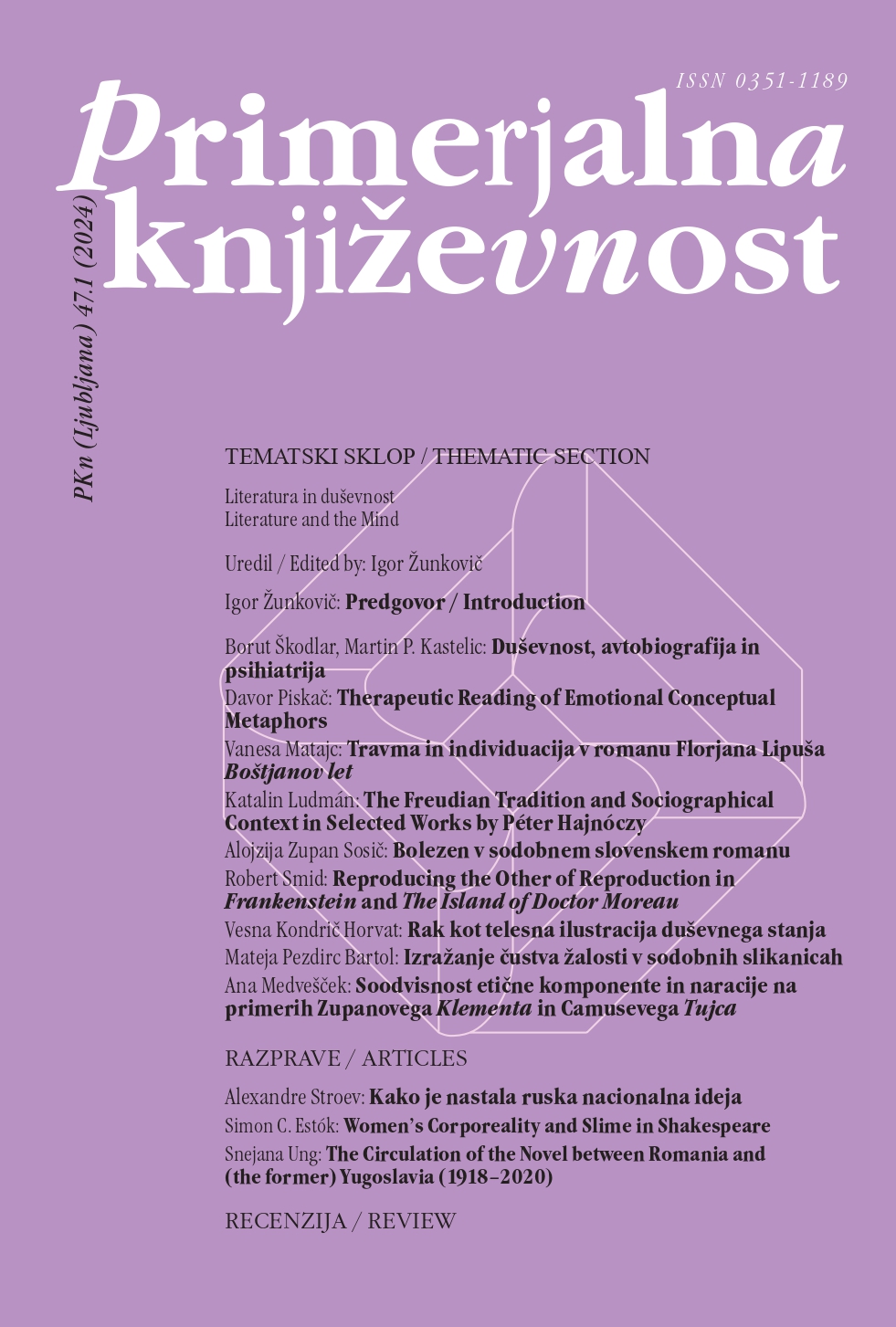Ženska telesnost in koncept sluzi pri Shakespearu: uprizarjanje antropocena
DOI:
https://doi.org/10.3986/pkn.v47.i1.11Ključne besede:
angleška dramatika, Shakespeare, William, ženske, mizoginija, telesna odvratnost, vaginofobija, sluz, ekokritištvoPovzetek
Prepletenost okolja, mizoginije in sluzi v Shakespearjevem delu in času tako rekoč napove antropocen. Razumeti to uprizarjanje pomeni najprej razumeti osnovne teorije o sluzi. Med redkimi teorijami o tem so trditve, da gre za snov, ki sega čez meje, se izmika sestavni čistosti, zbuja strah in gnus; to je snov, ki navdaja z grozo razkroja, čeprav ima obenem temeljno vlogo pri nastanku in kontinuiteti življenja. Osrednje spoznanje nove materialistične teorije temelji na delovanju ne-človeškega, pri čemer deluje sluz na načine, ki povzročajo različne vrste strahu. Zanimiva spoznanja Jean-Paula Sartra postanejo še bolj dragocena v trenutku, ko to sluz teoretizira, ji pri tem določi spol in jo prepoji z lastnimi strahovi in svojo različico mizoginije. Da bi doumeli, kako bistvena je sluz za oblikovanje teorij o mizoginiji in ekofobiji, moramo takšno uprizarjanje videti kot seksistično, namesto da bi bili Sartrovi apologeti. Najprimernejša vstopna točka za te teme pri obravnavi zgodnjega novega veka je uprizarjanje vaginofobije.
Literatura
Alberti, Fay Bound. “A Darke and Vicious Place: Conceptualizing the Vagina: How Women’s Sex Organs Have Been Understood in Art and in History.” Literary Hub, 25 July 2016, https://lithub.com/a-darke-and-vicious-place-conceptualizing-the-vagina/. Accessed 8 April 2024.
Barnes, Hazel E. “Sartre and Sexism.” Philosophy and Literature, vol. 14, no. 2, 1990, pp. 340–347.
Behringer, Wolfgang. “Climactic Change and Witch-Hunting: The Impact of the Little Ice Age on Mentalities.” Climate Change, vol. 43, no.1, 1999, pp. 335–351.
Brayton, Daniel. “Shakespeare and Slime: Notes and the Anthropocene.” Ecological Approaches to Early Modern English Texts: A Field Guide to Reading and Teaching, edited by Jennifer Munroe, Edward J. Geisweidt and Lynne Bruckner, Ashgate, 2015, pp. 81–89.
Bredbeck, Gregory W. Sodomy and Interpretation: Marlowe to Milton. Cornell University Press, 1991.
Camara, Anthony. “Abominable Transformations: Becoming-Fungus in Arthur Machen’s The Hill of Dreams.” Gothic Studies, vol. 16, no. 1, 2014, pp. 9–23.
Carroll, Noël. The Philosophy of Horror, or Paradoxes of the Heart. Routledge, 1990.
Chiari, Sophie. Shakespeare’s Representation of Weather, Climate and Environment: The Early Modern “Fated Sky”. Edinburgh University Press, 2019.
Cohen, Ed. “Are We (Not) What We Are Becoming? ‘Gay,’ ‘Identity,’ ‘Gay Studies,’ and the Disciplining of Knowledge.” Engendering Men: The Question of Male Feminist Criticism, edited by Joseph A. Boone and Michael Cadden, Routledge, 1990, pp. 161–175.
Collins, Margery, and Christine Pierce. “Holes and Slime: Sexism in Sartre’s Psychoanalysis.” Women and Philosophy: Toward a Theory of Liberation, edited by Carol C. Gould and Marx W. Wartofsky, Putnam’s Sons, 1976, pp. 112–127.
Estók, Simon C. The Ecophobia Hypothesis. Routledge, 2018.
Estók, Simon C. “Environmental Implications of the Writing and Policing of the Early Modern Body: Dismemberment and Monstrosity in Shakespearean Drama.” Shakespeare Review, vol. 33, 1998, pp. 107–142.
Estók, Simon C. “The Slimic Imagination and Elemental Eco-Horror.” ZAA: Zeitschrift für Anglistik und Amerikanistik, vol. 70, no. 1, 2022, pp. 59–74.
Foucault, Michel. The History of Sexuality—Volume 1: An Introduction. Translated by Robert Hurley, Vintage, 1990.
Gaard, Greta. “New Directions for Ecofeminism: Toward a More Feminist Ecocriticism.” ISLE: Interdisciplinary Studies in Literature and Environment, vol. 17, no. 4, 2010, pp. 643–665.
Gaard, Greta. “Green, Pink, and Lavender: Banishing Ecophobia Through Queer Ecologies.” Ethics and Environment, vol. 16, no. 2, 2011, pp. 155–226.
Grosz, Elizabeth. Volatile Bodies: Towards a Corporeal Feminism. Indiana University Press, 1994.
Hurley, Kelly. The Gothic Body: Sexuality, Materialism, and Degeneration at the Fin de Siècle. Cambridge University Press, 1996.
Laqueur, Thomas. Making Sex: Body and Gender from the Greeks to Freud. Harvard University Press, 1990.
Marchesini, Roberto. The Virus Paradigm: A Planetary Ecology of the Mind. Translated by Sarah De Sanctis, Cambridge University Press, 2021.
Mui, Constance. “Sartre’s Sexism Reconsidered.” Auslegung, vol. 16, no. 1, 1990, pp. 31–41.
Nussbaum, Martha. “The Roots of Male Rage, on Show at the Kavanaugh Hearing.” The Washington Post, 29 September 2018, https://www.washingtonpost.com/news/democracy-post/wp/2018/09/29/the-roots-of-male-rage-on-show-at-the-kavanaugh-hearing/. Accessed 4 April 2024.
Paglia, Camille. Sexual Personae: Art and Decadence from Nefertiti to Emily Dickinson. Vintage, 1990.
Paster, Gail Kern. The Body Embarrassed: Drama and the Disciplines of Shame in Early Modern England. Cornell University Press, 1993.
Read, Sara. Menstruation and the Female Body in Early Modern England. Palgrave, 2013.
Sartre, Jean-Paul. Being and Nothingness: A Phenomenological Essay on Ontology. Translated by Hazel E. Barnes, Washington Square, 1984.
Shakespeare, William. King Lear. The Riverside Shakespeare, 2nd Edition, edited by G. Blakemore Evans et al., Houghton Mifflin, 1997, pp. 1297–1354.
Shakespeare, William. Titus Andronicus. The Riverside Shakespeare, 2nd Edition, edited by G. Blakemore Evans et al., Houghton Mifflin, 1997, pp. 1065–1100.
Shakespeare, William. “Sonnet 153.” The Riverside Shakespeare, 2nd Edition, edited by G. Blakemore Evans et al., Houghton Mifflin, 1997, p. 1871.
Shakespeare, William. Hamlet. The Riverside Shakespeare, 2nd Edition, edited by G. Blakemore Evans et al., Houghton Mifflin, 1997, pp. 1183–1245.
Sharp, Jane. The Midwives Book; or, the Whole Art of Midwifry Discovered. Edited by Elaine Hobby, Oxford University Press, 1999.
Wedlich, Susanne. Slime: A Natural History. Granta, 2021.
Weisman, Alan. The World Without Us. Picador, 2007.
Wilson, Robert Rawdon. The Hydra’s Tale: Imagining Disgust. University of Alberta Press, 2002.


